Worry-Free Outdoor Time and a Lovely Garden.
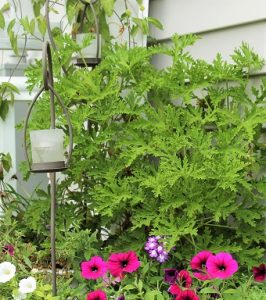 You can put away that bug spray and stop hiding indoors once the sun goes down with a garden full of beautiful mosquito-repellent plants. Citronella Geranium (aka Mosquito Plant) and Lemon Grass are easy-to-grow, thrive in all U.S. summer climate zones, and are perennial in the South. It’s not tool late to plant! Our plants are lush, full, and ready to fill those empty spots in your garden. Perfect for deck containers, foundations, and flowerbeds, just a few minutes of digging and you’ll have a lovely, chemical free mosquito-repellent garden all summer long!
You can put away that bug spray and stop hiding indoors once the sun goes down with a garden full of beautiful mosquito-repellent plants. Citronella Geranium (aka Mosquito Plant) and Lemon Grass are easy-to-grow, thrive in all U.S. summer climate zones, and are perennial in the South. It’s not tool late to plant! Our plants are lush, full, and ready to fill those empty spots in your garden. Perfect for deck containers, foundations, and flowerbeds, just a few minutes of digging and you’ll have a lovely, chemical free mosquito-repellent garden all summer long!
Start Growing Your No Mosquito Garden Today!
Citronella Geranium, Lemongrass, and Lantana Camara already top popular gardening lists because they’re robust and quick growers; adaptable to almost all conditions; gorgeous in every setting; and in Southern climates (Zone 9 and warmer), hardy enough to grow as perennials.
Best of all, when cut, bruised, or even jostled by a breeze, they give off a pleasant lemony, citronella scent that mosquitoes avoid.
CITRONELLA GERANIUM (MOSQUITO PLANT)
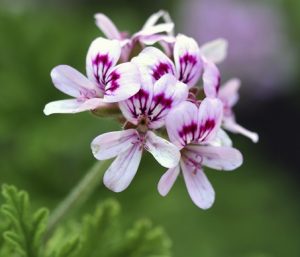
Citronella Geranium grows large and bushy with thick foliage of lacy, medium-green leaves and produces a few pink-purple blossoms during the season. Like all geraniums, Mosquito Plant should be planted outside after all danger of frost, needs direct sunlight for at least 6 hours per day but can tolerate partial shade, and prefers well-drained, moderately-rich soil.
It makes a great container addition but give it room to grow as it will reach up to 4 feet high and 2 feet wide. Toward mid-summer, prune back woody branches to keep plant nicely shaped. Look for the main central stem and cut it back to the preferred height — this will promote outward, side stem growth and encourage more blossoms.
Add trimmed branches to floral arrangements as the thick leaves provide a good structure for smaller flowers. Citronella Geranium can be overwintered using regular geranium propagation techniques.
LEMONGRASS (CYMBOPOGON CITRATUS)
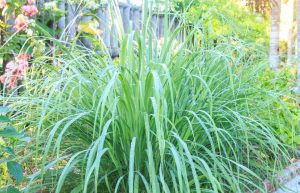
This edible plant is often grown as an ornamental and grows in a dense, rounded clump reaching up to four-feet high and three-feet wide. Similar to scallions, the grassy stems grow out of a thick bulbous base which is frequently used in Asian or Thai cooking.
Follow the same general planting instructions as Citronella Geranium: full sun but partial shade tolerant, prefers well-draining, loamy soil, and does best if watered consistently. Lemongrass bulbs can be harvested throughout the entire growing season.
When mature, this plant benefits from division as it can become root bound. Just slice into the crown with a sharp knife or spade and separate each root clump. Replant in a pot or in the ground and feed and water until established.
Unlike most plants, Lemongrass will grow in soil with black walnut residue.
LANTANA (LANTANA CAMARA)
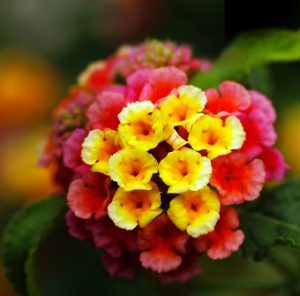
Sometimes called Yellow Sage or Shrub Verbena, Lantana has been a popular bedding plant for decades. All summer long, it produces lovely verbena-shaped blossoms in multiple color combinations of pink, red, yellow, orange, and purple.
The foliage grows in an upright and sturdy pattern making it a great container choice and, best of all, it thrives in nearly all growing conditions especially low moisture, hot sun, and even salty soils.
Deer and other critters dislike the taste and smell but butterflies and hummingbirds love it.
A note to families with kids and pets: Some varieties produce a small berry-like fruit that turns black when mature. These are poisonous so just trim off when they first appear in their green stage.
Many of the herbs you already love to grow also work to keep mosquitoes away from your outdoor spaces! Move them from the garden plot to your deck or patio containers and you’ll have a multi-purpose garden that keeps bugs away and gives you a mini herb garden right outside your door. These herbs also look just lovely combined with traditional container elements such as wave petunias or lobelia.
(Citronella Geranium, Lantana, or Lemon Grass).
If planting in one large container, just be sure to put plants together with similar sun, water, and soil requirements. And don’t be afraid to experiment with color, shape, and scent – with these choices you can build interesting planters that look great all summer long.
Most of these herbs work to repel mosquitoes because they give off a lemony, citronella scent. While humans, butterflies, and hummingbirds love this smell, it drives biting insects away! Here’s the top four herb choices for fending off mosquitoes.
‘Creeping Lemon’ Thyme
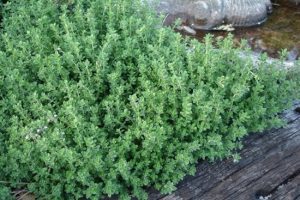
This low-growing, trailing herb fits well in rocky and sandy locations and adds a lemony kick to your summer cooking. The lovely leaves release a burst of citronella scent when bruised or rubbed and its vining growth pattern makes it a great “spiller” addition to most containers.
‘Creeping Lemon’ Thyme is a great companion plant for cabbage and broccoli but can be invasive if not kept trimmed back. Better yet, deer hate it but bees, butterflies, and hummingbirds love it!
Plant grows as perennial in Zones 4 and warmer; requires no overwintering protection; prefers at least six hours of sun per day; and tolerates most types of soil.
Rosemary
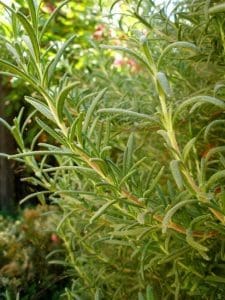
This workhorse garden plant adds delicious flavor to grilled chicken and veggies; grows like a champ and fits perfectly into containers; and keeps the mosquitoes away.
Rosemary is an upright, evergreen-like herb that grows as an annual in most Zones but can be overwintered in containers. It withstands a wide range growing conditions but prefers full sun, well-draining or sandy soil, and does best if soil is allowed to dry out between waterings.
Plant can be pruned regularly to maintain a bushy shape but trim off no more than one-third of overall growth and prune above leaf joints. Use these trimmings in outdoor bouquets; tie in bundles and dry for later use; or toss on the campfire for a smoky, scented repellent. Rosemary also makes a great garden companion as it deters bean-hungry bugs, parasites, and cabbage flies.
Mint (any variety)

Here’s one more reason to love mint! This hardy herb is a fast and perennial grower in most Zones and thrives in nearly all conditions. It comes in lots of interesting varieties such as Apple Mint or Chocolate Mint and adds delicious flavor to every dish and cocktail all while keeping mosquitoes from crashing your party.
Plant prefers full sun and well-draining soil and should be trimmed back periodically. Mint also works to deter ants, aphids, and cabbage flies so it’s a good companion for cabbage, kohlrabi, broccoli, and kale.
Lavender
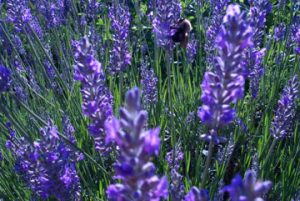
No cottage garden is complete without this gorgeous flowering herb. It not only repels mosquitoes but also deters fleas, ticks, and even mice while at the same time attracting beneficial insects, butterflies, and birds. Lavender prefers full sun; well-draining soil; infrequent but deep waterings; and occasional pruning. Grows as a perennial in Zones 5 and warmer but in Southern climates, the plant must have good drainage all winter.
Stems can be bundled and hung to dry and will continue to give off a lovely scent making it a favorite for sachets and potpourris. You can even make a natural insect repellent that almost smells like perfume (more on that in our next article).
Some Quick Garden Design Ideas
For the best mosquito-repelling benefit, group these herbs together in containers and place in high use areas such as patios or decks. Try filling window boxes (see top image) with trailing herbs such as creeping thyme or tuck some mint along your walkways and into foundation beds.
Lavender and Rosemary can be shaped with creative pruning – try sculpting a mini-hedge or topiary in your outdoor spaces for a great conversation piece that also works as a bug deterrent.
Lemongrass is more than just a beautiful garden plant – it’s a favored ingredient in Asian and Thai cooking, perfect for stir fries, marinades, and grilling. All portions of the plant are edible and add lemony flavor from Happy Hour to the dessert course.
This great plant also grows well all season so you can harvest frequently through the summer.
Harvesting Lemongrass
Lemongrass grows lots of stems out of a bulbous base and the lower portions are edible. When stalks reach about ½-inch thick and the plant is at least 12 inches tall, you can harvest the stem.
Just twist off at the base (much like picking rhubarb) or cut off with a sharp knife. The plant will continue to grow throughout the season and can be harvested until the first frost.
Cooking with Lemongrass
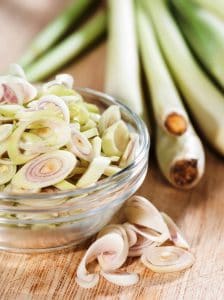
After harvesting, remove the outer, woody layers and leaf tips as they can taste bitter. The remaining portions of the plant are all edible and will add a delicious hint of lemon to your dishes. Here are just a few ideas for cooking with this amazing plant:
Fresh Leaves. Whole fresh leaves can be tough and must be mashed, simmered, and chopped very finely if you plan on eating them. They can be used, though, brewed into hot or cold tea; coarsely chopped and added to marinades or stews, or submerged in oil or vinegar for a lemon infusion.
Dried Leaves. Place in a dehydrator and dry to the point where leaves can be crumbled and ground such as with a bay leaf. Store in an airtight container and use either whole or ground to flavor meats, vegetables, and sauces. Whole dried leaves are great added to stew or combined with other herbs for a meat rub.
Bulbs and Stalks. The bulbous portion and lower thicker stalks are the most commonly used part in cooking. Similar to how you would prepare scallions, slice into rings and add to stir fries or grilled dishes or slightly mash to release flavor into your dish.
Try using the whole stalk as a meat skewer when grilling to infuse your dinner with lemon-flavor. Lemongrass can have a hint of ginger which is complemented if combined with dishes using chili pepper, garlic, or turmeric. Mashed leaves, whole bulbs, or sliced rings can be frozen for up to six months.
Make Your Own Mosquito Repellent

Why turn to chemicals when you can use common garden plants and grocery ingredients to make your own mosquito repellent? All-natural and really effective, these concoctions have been used for centuries to deter insects. And the bonus: they’re much cheaper than store-bought bug sprays! Just make sure to test first on your skin or clothing to make sure it won’t cause a rash or damage the fabric.
Vinegar of Four Thieves Recipe
This powerful bug repellent dates from medieval times. Be warned: It is very strong smelling!
Ingredients:
• 32 oz. Apple Cider Vinegar
• 2 Tbsp of each of these dried herbs: sage, rosemary, lemon thyme, mint, and lavender
Directions:
Combine vinegar and herbs into a large glass jar and seal tightly. Shake well every day for three weeks. After 3 weeks, strain the herbs. Mix remaining liquid with equal parts water and keep in the refrigerator in a spray bottle.
Herb Combo Witch Hazel Spray Recipe
This spray uses multiple fresh or dried herbs and smells great while keeping bugs at bay. Tweak your batch to make your own signature scent.
Ingredients:
• 1 cup distilled water
• 1 cup witch hazel
• 4 Tbsp dried herbs or 1 cup of chopped herbs (include at least one mint family herb)
Directions:
Bring distilled water to a boil and add herbs. Stir well and turn off heat. Cover and let steep until cooled. Strain herbs and mix remaining liquid with witch hazel. Pour into a spray bottle and keep refrigerated.
You can also use these recipes to make a homemade “mosquito strip” by spraying them onto pieces of cloth and hanging near your outdoor spaces. To keep the odor strong, you’ll need to keep the strips moist, though, so the concoction doesn’t quickly evaporate.
Source: http://www.motherearthnews.com/